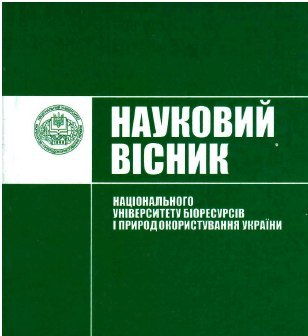Тranslation transformations in the agricultural texts (on the material of German-Ukrainian translations)
DOI:
https://doi.org/10.31548/philolog0(263).2017.0201%20-%20208Abstract
Analysis of translation transformations in the agricultural texts (on the material of German-Ukrainian translations)
Introduction. Language support of the agricultural sector is one of the oldest stratums of language in general. The formation of it had been continued from ancient times and was largely replenished with professional neologisms because of continuous dynamic development. Depending on the level of economic development and scientific progress within certain country, the general style of agriculture and agribusiness features, language support of agricultural sector of different countries varies significantly, which is a great problem in terms of translation of field texts.
That’s why nowadays it is necessary to do some precise, develop and systematize a range of various approaches, which are used when translating agrarian publications, as well as official sites of large agricultural enterprises.
Purpose. The aim of the article is to analyze the translations of German agrarian texts in the aspect of usage the translation transformations of different levels and scope of influence on the content of the target text in them.
Results. To organize our investigation we chose the articles posted on the official German site of the company Big Dutchman, which is specialized on production of modern equipment for poultry- and pig-farming.
The articles were analyzed for the use of translation transformations in them. The TT typology, which we chose, is created on the basis of language semiosis trine, developed by Ch. Morris. This trine demonstrates the relationships between semantics, syntax and pragmatics. A change of every of this components causes a change in another one, as they are closely connected. Being oriented on this fact, O. O. Selivanova defines such TTs: formal, formal and semantic, and pragmatic, every of which can be represented on phonographic, morphological, lexical and syntactical levels.
So, the task of our investigation was to precisely analyze TTs, which are represented in the Ukrainian translations of German agrarian texts, and demonstrate statistically the place of every type of TT in agricultural texts (on the basis of analyzed articles).
Therefore, it was founded following statements: 1. It was determined that there are near 157 transformations in the analyzed articles. They are of different levels of organization of language items and range of impact on the content of represented information. 2. Most of all, in the agrarian texts, as well as in every language message, are presented formal transformation on the lexical level, used to avoid tautology (change of nouns by pronouns, notions by their synonyms). We have decided to neglect such cases and not to analyze them separately. 3. Most TTs are of formal nature (near a half of all transformations), the least – pragmatic. Formal and semantic transformations occupy the mediate place. Quantitatively formal TTs are represented by 79 changes of translation, formal and semantic – 60, and pragmatic – 18. 4. As to the level of transformation: a) the most transformations happen on the syntactical level, followed by lexical, then – morphological, on the phonographic level there are only formal transformations; b) syntactical, lexical, and morphological transformations are the most frequent in formal aspect; c) pragmatic transformations happened only on the syntactical and lexical levels of organization of language units.
Conclusion. Qualitative and quantitative analyses of TTs represent certain translation strategies, methods and techniques, as well as their numeral definition, which is a very interesting material for investigation and improvement of demonstrated hypotheses. For the more precise and thorough analyses it is necessary to develop the theory of TTs, especially the typology of TTs, and extant the base of original agrarian texts and their translations.
References
Barkhudarov, L. S. (1975) Yazyk i perevod [Language and translation]. Moscow: Mezhdunar. otnosheniya, 240.
Barkhudarov, L. S. (1984) Nekotorye problemy perevoda angliyskoy poezii na russkiy yazyk [Certain problems of Russian translation of English poetry]. Tetradi perevodchika. Moscow: Vysshaya shkola, 21, 38–48.
Komissarov, V. N. (1990) Teoriya perevoda [Theory of translation]. Moscow: Vysshaya shkola, 254.
Latyshev, L. K. (2005) Tehnologiya perevoda [Technology of translation]. Moscow: Akademiya, 317.
Morris, Ch. (1983) Osnovaniya teorii znakov [Foundations of the Theory of Signs]. Semiotika. Moscow, 37–89.
Retsker Ya. I. (2006) Teoriya perevoda i perevodcheskaya praktika: Ocherki lingvisticheskoy teorii perevoda [Theory of translation and translational practice: Study of linguistic theory of translation]. Moscow: Mezhdunarodnye otnosheniya, 240.
Selivanova, O. O. (2012) Nova typolohiya perekladats'kykh transformatsiy (na materiali ukrayins'ko-rosiys'koho perekladu) [The New Typology of Translation Transformations (on the Material of Ukrainian-Russian Translation)] Visn. Cherkas. Un-ty. Ser. Filol. Nauky, 7, 3–12.
Yemel'yanova Ye. S. Morfolohichna adaptatsiya hallitsyzmiv u suchasniy ukrayins'kiy sil's'kohospodars'kiy terminolohiyi [Morphological Adaptation of Galiсisms in Modern Ukrainian Agricultural Terminology], 134–136. Available at http://dspace.nbuv.gov.ua/
Downloads
Published
Issue
Section
License
Relationship between right holders and users shall be governed by the terms of the license Creative Commons Attribution – non-commercial – Distribution On Same Conditions 4.0 international (CC BY-NC-SA 4.0):https://creativecommons.org/licenses/by-nc-sa/4.0/deed.uk
Authors who publish with this journal agree to the following terms:
- Authors retain copyright and grant the journal right of first publication with the work simultaneously licensed under a Creative Commons Attribution License that allows others to share the work with an acknowledgement of the work's authorship and initial publication in this journal.
- Authors are able to enter into separate, additional contractual arrangements for the non-exclusive distribution of the journal's published version of the work (e.g., post it to an institutional repository or publish it in a book), with an acknowledgement of its initial publication in this journal.
- Authors are permitted and encouraged to post their work online (e.g., in institutional repositories or on their website) prior to and during the submission process, as it can lead to productive exchanges, as well as earlier and greater citation of published work (See The Effect of Open Access).

